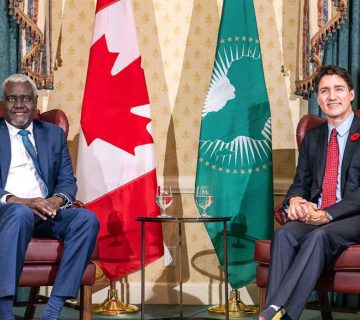The use of waters of Africa’s longest river, the Nile, by Ethiopia, a key Nile water source country, and Egypt, a downstream country, is creating (re)alignments, and threatening national and regional securities. At the heart of this water governance issue are colonial-era treaties that other 10 Nile Basin countries think have been disproportionately benefitting Egypt. Innovative and sustainable use of this shared resource will result from negotiated collaboration – as opposed to a zero-sum approach – and de-escalation of the existing ‘tension’ for regional peace and stability.
Bones of Contention
In the course of the last decade, Egypt has voiced its displeasure with Ethiopia’s construction of what is set to become one of Africa’s largest dams, the Grand Ethiopian Renaissance Dam (GERD), on the Blue Nile in Ethiopia. The Blue Nile, according to water scientists, flows from Lake Tana that supplies an estimated 85 per cent of all of River Nile waters. The White Nile, which originates in Uganda, supplies the remaining proportion of water. The Blue and White ‘Niles’ converge in Khartoum, Sudan, as the River courses to Egypt, making Sudan a ‘conduit’ Nile water country. Egypt, on the one hand, is concerned that the Dam will deny the mostly hot desert, drought-prone country of a steady supply of water that 90 per cent of its population is considerably dependent on. Egypt is worried about the length of time it will take to fill the Dam, and uncertain about “the mechanism of dam operation during and after filling the reservoir,” as well as the possibility of the Dam being linked “to all other dams on the Nile” when the dam is being filled, according to Mohamed el-Sibai, Egypt’s spokesperson, Ministry of Water Resources and Irrigation. Egypt has, thus, proposed the conditional filling of the Dam, during the rainy season only.
Ethiopia, on the other hand, is keen on completing the project that began in 2011 to ‘electrify’ Ethiopia, and the greater Horn of Africa region. It has acknowledged that the production of the targeted 6,000 megawatts of hydroelectricity will adversely affect downstream countries in terms of water security and livelihoods. However, as a key source country that the two colonial-era treaties (of 1929, and 1959 that granted Egypt and Sudan the rights to almost all of Nile’s waters) overlooked, Ethiopia feels affronted by Egypt’s apparent dictation of how Ethiopia should use her natural resource. Ethiopia’s foreign ministry is disgruntled by Egypt’s proposal that will likely double the Dam filling time to more than 12 years, and to compensate Egypt for the cumulative deficit the filling may create. The said treaties included Sudan and Egypt, but the former, a Key Nile water recipient, is siding with Ethiopia on the Dam matter as it stands to benefit more by allying with Ethiopia than with Egypt. Most of the other riparian states upstream which have long protested Egypt’s approach to the access and use of the shared resource have followed suit. The US and the African Union, have been roped in to mediate the unresolved matter, and meetings on the resolution of this row are being held in different locations in Africa, and the US. In mid-January 2020, Ethiopia indicated it would consider filling the Dam during the rainy season. This tension-de-escalating agreement is tentative.
Adopting ‘Soft’ Approaches
A three-step ‘soft’ approach can help to resolve this matter. Egypt should acknowledge the discriminatory nature of the dated treaties that have largely disenfranchised most of the other Nile Basin states. While this may hurt Egypt’s ego somewhat, it will also increase its standing with the other Nile River stakeholder countries (key among them Kenya, Uganda, Tanzania, Rwanda, Burundi, Democratic Republic of Congo, Eritrea, and South Sudan too), and open the door for honest deliberations on the current uses of the shared resource. Such discussions could hinge on the Nyerere doctrine of applying only mutually acceptable and viable pre-colonial agreements in post-independence Africa.
This truth and reconciliation process should be followed by the creation of new Nile water governance mechanisms; specifically, all-inclusive negotiated treaties between the 11 countries. In this context, Egypt’s idea of linking other dams on the Nile may be considered. However, Egypt should not expect Ethiopia to agree to link its crown jewel to just any other dam on the Nile after the fact because the USD 4 billion ground-breaking project is already underway. It should also be noted that the generation of hydro-electricity at Aswan (Egypt), Owen (Uganda), and GERD may be a shared objective, but Ethiopia’s motivation and ambitions for GERD are unlike that of the other projects on the Nile. These realities should be taken into account in the creation of future treaties relating to Nile water use.
The final step is to climate-proof the Nile jointly. Climate-proofing the more than 6,000 kilometers-long River will entail a concerted, 11-states-strong forestation campaign, and the construction of sun-arresting canopies over the riparian areas with limited forest cover. Forestation will increase rainfall, addressing drought, and the volume of water in the Nile, which are the bane of Egypt. The moisture that collects under the solar panels and the generated solar energy generated will complement electricity production initiatives of downstream states.
Egypt, unlike all the other Nile Basin states, has the luxury of being bordered by two Seas (Mediterranean and Red). It should also look beyond the Nile, and use state-of-the-art water technologies to harness the Seawaters for power generation and domestic use. Egypt could go a step further, and channel excess Seawater to other upstream countries, into the linked-up dam system already highlighted here.
In sum, the 11 states should be involved in equal access, sensible and sustainable use of Nile waters; and equitable funding and coordination of the aforementioned steps. These will help end Nile water ‘rows’ for good.
Roselyne Omondi is the Associate Director, Research, at the HORN Institute.
Photo: Ministers from Ethiopia, Egypt, and Sudan attending a two-day conference in Washington, DC concerning the filling and operation of the Grand Renaissance Ethiopian Dam (GERD) that Ethiopia is building on a tributary of the Nile (Photo Credit: CGR)



